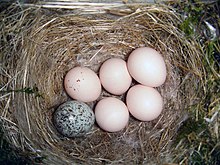White-bellied phoe bully
| White-bellied phoe bully | ||||||||||||
|---|---|---|---|---|---|---|---|---|---|---|---|---|

White-bellied phoebe ( Sayornis phoebe ) |
||||||||||||
| Systematics | ||||||||||||
|
||||||||||||
| Scientific name | ||||||||||||
| Sayornis phoebe | ||||||||||||
| ( Latham , 1790) |
The white-bellied phoebe bully ( Sayornis phoebe ) is an American screeching bird . The name of the long-tailed tyrant comes from the two-syllable chant ("fii-bii") that both males and females constantly recite in summer. In English, it sounds similar to the woman's name Phoebe .
features
The white-bellied Phoebetyrann reaches a body length of 14 to 17 centimeters and a wingspan of 26 to 28 centimeters. Its weight is between 16 and 21 grams. There is no gender dimorphism to speak of , except that the females tend to stay a little smaller than the males.
The throat as well as the chest and the belly are colored whitish, which also led to the German-language naming. The side of the breast shows a light gray transition to the gray-brown to olive-brown upper plumage. The wings can show whitish borders, especially in autumn. The head appears large in relation to the body and has a slightly darker brown color than the surrounding plumage. The beak is short, thin and pointed and therefore well suited for grasping insects. Like the legs, it is colored black. The eye ring and the iris are also black.
distribution and habitat
The breeding areas of the white-bellied phoebetyrant are in the eastern United States and in southeastern to central Canada . In September and November it moves from its northern distribution areas to its winter quarters in Mexico and the southern USA. It is considered to be one of the first migratory birds to return to their breeding grounds in North America in spring. In the southeastern distribution area within the USA it remains in the breeding area all year round.
The white-bellied phoe bully is considered to be a follower of culture , as many man-made structures such as wall protrusions, rain gutters, bridges or drainage channels accommodate his nesting habits. Before the dense human settlement of North America, it built its nests on protected rock ledges. The white-bellied phoe bully resembles the barn swallow in his claims , whose abandoned nests he sometimes uses.
The white-bellied phoe bully needs wooded areas with thick undergrowth and bodies of water near its nest. This habitat offers protection and camouflage as well as hiding places from which it can hunt insects.
Way of life
The white-bellied phoebetyrants mostly live as loners. The two sexes only meet in the mating season and stay together for one season, but they are rarely seen as couples. Like all representatives of the bird family of tyrants, the white-bellied phoe bully defends his territory with loud screams and daring flight maneuvers against intruders, even if they are much larger than him.
The hunt for flying insects takes place from the hide. Fruits and seeds are also eaten in winter.
Reproduction

The nest is cup-shaped and is built by the female with mud and plant material under bridges or on buildings. The clutch comprises 3–5 eggs, these are whitish and sometimes have brown speckles on the wider side of the egg. Brown-headed cowbird often lay their eggs in the nests of the white-bellied phoebetyrant.
Research history
The first bird to be ringed in North America was a white-bellied phoe bully. The ornithologist John James Audubon ringed it in 1804 in order to be able to prove its annual return to the breeding area. The ringing can also provide information about the lifespan of the birds. In 1989, for example, a white-bellied phoe bully was found in the Canadian province of Alberta who had been ringed in Iowa at the age of four months 10 years earlier .
Individual evidence
- ↑ Eastern Phoebe ( Sayornis phoebe ) , description, at All About Birds, Cornell Lab of Ornithology. Retrieved October 22, 2013.
- ^ Videos, photos and sound recordings on Eastern Phoebe (Sayornis-phoebe) in the Internet Bird Collection
- ↑ a b c d Eastern Phoebe ( Sayornis phoebe ) , Way of Life, at All About Birds, Cornell Lab of Ornithology. Retrieved October 22, 2013.
- ↑ Longevity Records Of North American Birds , Life Spans of Birds in North America, compiled by the USGS ' Patuxent Wildlife Research Center , as of May 2013. Retrieved October 22, 2013
literature
- HP Weeks Jr .: Eastern Phoebe (Sayornis phoebe). In: A. Poole & F. Gill (Eds.): The Birds of North America. No. 64, Philadelphia 1994
Web links
- Sayornis phoebe in the Red List of Threatened Species of the IUCN 2013. Posted by: Butchart, S. & Symes, A. (BirdLife International), 2012. Accessed October 22, 2013.
- Videos, photos and sound recordings of Eastern Phoebe (Sayornis-phoebe) in the Internet Bird Collection
